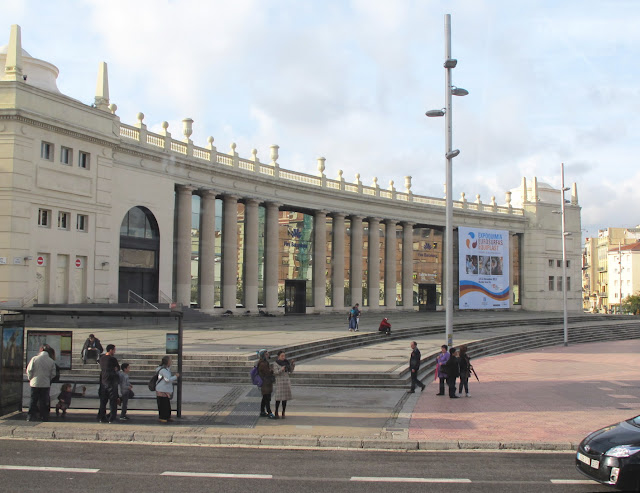 |
| Anonio Gaudi's - Sagrada Familia Cathedral |
End of a Voyage, Start of a New
Voyage
The Constellation took one more sea day to reach the end of my Voyage
to the Holy Land.
The stateroom stewards passed out complete
instructions for disembarkation early in the day. I took the next few hours repacking and
preparing my luggage for the move from one cabin to another cabin for the next
voyage – the Trans-Atlantic Crossing.
I also took the time to
set up my gratuities for extra services received by the excellent staff of the Constellation. Most cruise lines now collect $10 to $12
per day for the bulk of the gratuities to staff. I like to give extra for the people who help
me personally – I gave $30 for the two stateroom attendants, $5 to the
sommelier in the main dining room who always had a glass of diet cola with ice
waiting by my place at the dinner table, $5 to the dining room maître di, $10
for Benito the assistant dinner waiter and $20 for Elston the main waiter for
our table. I passed out those extra
gratuities that evening.
The ship’s crew work hard
– usually 12 to 14 hour days, sometimes in split shifts, 7 days a week with
just a few hours off in ports. They work on 5 to 6 month contracts and then
receive their air fare home for 6 week to two month breaks before returning for
another contract period. Middle class
passengers, such as me, are the beneficiaries of their hard work – otherwise
taking a cruise would be only available for the ultra wealthy.
At least one passenger
from each family or group was asked to attend a general disembarking briefing
in the ship’s large theater. At that
briefing full details were given about what to expect the following day during
the disembarking procedures, going through immigration and customs and so
forth.
I would be a “back to back
cruiser” – a passenger not disembarking in Barcelona, but staying for the next voyage of
the ship.
Disembarking passengers
received color coded and numbered luggage tags.
The colors and the numbers were based on the passenger’s ongoing
transportation arrangements. Those
passengers who had air flights departing before Noon were the very first
passengers to be disembarked. Their
luggage would also be sorted out below decks to be in the first carts of
luggage that would be taken to the Barcelona
arrival hall baggage claim area.
Everyone disembarking in Barcelona was advised to
put their luggage that was not their hand carried luggage out in the hallway
next to their stateroom door by 11PM the night before arrival.
People were reminded to
leave their next day’s clothing, medications, passports and wallets out of
their luggage or risk not having those items until after they had reclaimed
their luggage at dockside the next day.
Evidently it is not
uncommon for people to forget to leave travel clothing out of their luggage - causing
them to have to leave the ship wearing a Celebrity bathrobe!
The “back to back” cruise
passengers who were continuing on the ship across the Atlantic
Ocean were given special multi colored luggage tags with their new
stateroom numbers - with the instructions to keep all pieces of their luggage inside
the cabin overnight. The cabin
attendants would move the pieces to the new cabin during the day while the ship
was vacant of passengers.
The final dinner of the
Holy Land Cruise was that night. A
special treat of Baked Alaska was served to all in the dining room. The Baked Alaska was presented in grand fashion
with all the waiters parading the beautiful deserts with embedded cups of flaming brandy
around the entire dining room and then served to the clapping passengers. All of the meals on the cruise were just
amazing.
 |
| Elston and the Baked Alaska Desert. |
The ship would once again
require extra time for cleaning and disinfecting during the time in Barcelona. Back to back
cruisers would not be allowed to re-board the ship until after 3 PM in Barcelona. Celebrity allowed the 350 or so back to back
cruise passengers to take any one of the long tour excursions offered at the
port with no charge.
I selected to take the
city tour of Barcelona again. I had taken the same tour in 2009 on my last departure from Barcelona. The other choice was to take a tour into the
Pyrenees’ Mountains to visit the monastery at Montserrat.
Now that I look back on it, I wish I had chosen to go to Montserrat.
On Sunday, November 20th
the ship arrived in Barcelona. The weather was beautiful.
Disembarkment went
very well. The "back to back" cruise groups departed
about 9 AM. Our group went up to the city park that overlooks the city for an
overview. On the way we passed many of the buildings built for the Olympic
Games and the International Exposition held in Barcelona.
These buildings and other sports venues are still in use by the people
of Barcelona.






































































